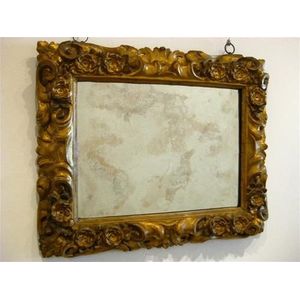18th Century Gilt Wall Mirror with Armorial
You must be a subscriber, and be logged in to view price and dealer details.
Subscribe Now to view actual auction price for this item
When you subscribe, you have the option of setting the currency in which to display prices to $Au, $US, $NZ or Stg.
- Cartouche - An ornamental panel in the form of of a shield, oval or rectangular scroll with curling edges. It may be carved into the back of a chair or the top of a sideboard, or present on a piece of silver or jewellery, and contain the initials of the original owner, heraldic symbols, or some other inscription, such as the details of a presentation.
In ceramics the term defines the central area of a vase or similar with a decorative border in one of the shapes above, into which a decorative scene or figures have been painted. - Acanthus - A stylized leaf motif, one of the primary decorative elements of classical Greek and Roman architecture, derived from the genus of flowering plants in the family Acanthaceae, native to tropical and subtropical regions of the Mediterranean area. It is a common element in classical Greek and Roman design, and is often seen in Corinthian and Composite order columns and used as a decorative element in English, European and Australian furniture, particularly on the curve of a leg, and as decoration for a corbel.
- Armorial / Armourial - Bearing a coat of arms. Coats of arms came into general use by feudal lords and knights in in the 12th century, and by the 13th century, arms had spread beyond their initial battlefield use to become a flag or emblem for families in the higher social classes of Europe. They were inherited from one generation to the next. When a family crest is used on individual items of silver or furniture it is an indicator of the aristocratic standing of the family represented.
Armorials were also used to decorate mass produced ceramic souvenir ware by such companies as Goss, Carlton & Shelley, and in these cases the coats of arms displayed were of boroughs and cities.
This item has been included into following indexes:
-
mirrors, wall, period, age or style
- Georgian 166
- overmantle 793
Visually similar items

A fine ornate carved wood mirror frame, English, late 17th century, 34 x 45 cm

A George II walnut and giltwood mirror, circa 1740, the rectangular replaced plate within a shaped walnut surround with gilded trim, the acanthus leaf crest with flanking rocaille and each side with carved foliate garlands, 134 cm x 67 cm

A French gilt wood cushion mirror, late 19th Century the water gilded mirror surmounted by a foliate scrolling crest, centred by an ovoid cartouche, with a beaded and scrollwork frame, 136 cm high, 102 cm wide

An elaborately carved and pierced French giltwood framed cushion front mirror 20th century, 226.5 cm high
